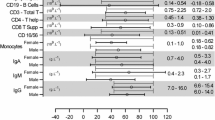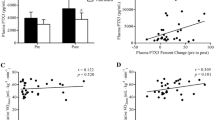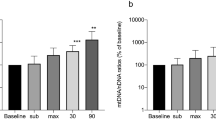Abstract
High-intensity exercise shares similarities with acute phase responses of inflammatory diseases. We investigated the influences of acute exercise on inflammatory markers, plasma pentraxin3 (PTX3) and serum high-sensitive C-reactive protein (CRP) (hsCRP). Nine healthy male subjects (41 ± 3 years old) participated. Each subject performed three types of exercise; ergometer exercise at 70% workload of anaerobic threshold (AT) for 30 min (70% AT exercise), peak ergometer exercise (peak EX, 20 watt increase/min until fatigue) and resistance exercises of 70% 1 RM (70% RE) until exhaustion. We measured plasma PTX3, serum hsCRP, lactate, noradrenaline (NOR), white blood cells (WBC), interleukin-6 (IL-6) and myeloperoxidase (MPO), a marker of neutrophil degranulation. The effects of exercise on intracellular PTX3 and MPO in neutrophils were also investigated, by using flow cytometry analysis. Circulating PTX3 and hsCRP significantly increased immediately after 70% RE and peak EX, while they did not increase after 70% AT exercise. The exercise-induced fold increase in PTX3 and hsCRP relative to the resting level was positively correlated with the changes in WBC, NOR, lactate and MPO. The exercise-induced fold increase in IL-6 was positively correlated with that in NOR, but not with that in PTX3 and hsCRP. Neutrophils isolated immediately after 70% RE, but not 70% AT exercise, exhibited lower mean fluorescence for PTX3 and MPO than those from pre-exercise blood. These results provide the evidence that high-intensity exercises significantly increase circulatory PTX3 as well as hsCRP. The release from peripheral neutrophils is suggested to be involved in the exercise-induced plasma PTX3 increase.






Similar content being viewed by others
References
Boehme M, Kaehne F, Kuehne A, Bernhardt W, Schröder M, Pommer W et al (2007) Pentraxin 3 is elevated in haemodialysis patients and is associated with cardiovascular disease. Nephrol Dial Transplant 22:2224–2229
Büttner P, Mosig S, Lechtermann A, Funke H, Mooren FC (2007) Exercise affects the gene expression profiles of human white blood cells. J Appl Physiol 102:26–36
Castell LM, Poortmans JR, Leclercq R, Brasseur M, Duchateau J, Newsholme EA (1997) Some aspects of the acute phase response after a marathon race, and the effects of glutamine supplementation. Eur J Appl Physiol Occup Physiol 75:47–53
Fehrenbach E, Niess AM, Passek F, Sorichter S, Schwirtz A, Berg A et al (2003) Influence of different types of exercise on the expression of haem oxygenase-1 in leukocytes. J Sports Sci 21:383–389
Hoffman-Goetz L, Pedersen BK (1994) Exercise and the immune system: a model of the stress response? Immunol Today 15:382–387
Inoue K, Sugiyama A, Reid PC, Ito Y, Miyauchi K, Mukai S et al (2007) Establishment of a high sensitivity plasma assay for human pentraxin3 as a marker for unstable angina pectoris. Arterioscler Thromb Vasc Biol 27:161–167
Jaillon S, Peri G, Delneste Y, Frémaux I, Doni A, Moalli F et al (2007) The humoral pattern recognition receptor PTX3 is stored in neutrophil granules and localizes in extracellular traps. J Exp Med 204:793–804
Kasapis C, Thompson PD (2005) The effects of physical activity on serum C-reactive protein and inflammatory markers: a systematic review. J Am Coll Cardiol 45:1563–1569
Kotooka N, Inoue T, Fujimatsu D, Morooka T, Hashimoto S, Hikichi Y et al (2008) Pentraxin3 is a novel marker for stent-induced inflammation and neointimal thickening. Atherosclerosis 197:368–374
Kunes P, Lonsky V, Mandak J, Kolackova M, Andrys C, Kudlova M et al (2007) The long pentraxin 3 in cardiac surgery: distinct responses in “on-pump” and “off-pump” patients. Scand Cardiovasc J 41:171–179
Latini R, Maggioni AP, Peri G, Gonzini L, Lucci D, Mocarelli P et al (2004) Lipid Assessment Trial Italian Network (LATIN) Investigators. Prognostic significance of the long pentraxin PTX3 in acute myocardial infarction. Circulation 110:2349–2354
Li SP, Goldman ND (1996) Regulation of human C-reactive protein gene expression by two synergistic IL-6 responsive elements. Biochemistry 35:9060–9068
Macintyre SS, Kushner I, Samols D (1985) Secretion of C-reactive protein becomes more efficient during the course of the acute phase response. J Biol Chem 260:4169–4173
Malaponte G, Libra M, Bevelacqua Y, Merito P, Fatuzzo P, Rapisarda F et al (2007) Inflammatory status in patients with chronic renal failure: the role of PTX3 and pro-inflammatory cytokines. Int J Mol Med 20:471–481
Mantovani A, Garlanda C, Doni A, Bottazzi B (2008) Pentraxins in innate immunity: from C-reactive protein to the long pentraxin PTX3. J Clin Immunol 28:1–13
McCarthy DA, Macdonald I, Grant M, Marbut M, Watling M, Nicholson S et al (1992) Studies on the immediate and delayed leucocytosis elicited by brief (30-min) strenuous exercise. Eur J Appl Physiol Occup Physiol 64:513–517
Mooren FC, Lechtermann A, Fobker M, Brandt B, Sorg C, Völker K et al (2006) The response of the novel pro-inflammatory molecules S100A8/A9 to exercise. Int J Sports Med 27:751–758
Muller B, Peri G, Doni A, Torri V, Landmann R, Bottazzi B et al (2001) Circulating levels of the long pentraxin PTX3 correlate with severity of infection in critically ill patients. Crit Care Med 29:1404–1407
Nakajima T, Kurano M, Iida H, Takano H, Fukuda T, Nagasaki M et al (2009) Improvement of plasma pentraxin3 following cardiac rehabilitation in patients with cardiovascular diseases. Circulation 120:S434
Natale VM, Brenner IK, Moldoveanu AI, Vasiliou P, Shek P, Shephard RJ (2003) Effects of three different types of exercise on blood leukocyte count during and following exercise. Sao Paulo Med J 121:9–14
Ostrowski K, Schjerling P, Pedersen BK (2000) Physical activity and plasma interleukin-6 in humans-effect of intensity of exercise. Eur J Appl Physiol 83:512–515
Peake J, Wilson G, Hordern M, Suzuki K, Yamaya K, Nosaka K et al (2004) Changes in neutrophil surface receptor expression, degranulation, and respiratory burst activity after moderate- and high-intensity exercise. J Appl Physiol 97:612–618
Peake JM, Suzuki K, Wilson G, Hordern M, Nosaka K, Mackinnon L et al (2005a) Exercise-induced muscle damage, plasma cytokines, and markers of neutrophil activation. Med Sci Sports Exerc 37:737–745
Peake J, Nosaka K, Suzuki K (2005b) Characterization of inflammatory responses to eccentric exercise in humans. Exerc Immunol Rev 11:64–85
Pedersen BK, Hoffman-Goetz L (2000) Exercise and the immune system: regulation, integration, and adaptation. Physiol Rev 80:1055–1081
Pepys MB, Hirschfield GM (2003) C-reactive protein: a critical update. J Clin Invest 111:1805–1812
Petersen AM, Pedersen BK (2005) The anti-inflammatory effect of exercise. J Appl Physiol 98:1154–1162
Phillips T, Childs AC, Dreon DM, Phinney S, Leeuwenburgh C (2003) A dietary supplement attenuates IL-6 and CRP after eccentric exercise in untrained males. Med Sci Sports Exerc 35:2032–2037
Plaisance EP, Grandjean PW (2006) Physical activity and high-sensitivity C-reactive protein. Sports Med 36:443–458
Presta M, Camozzi M, Salvatori G, Rusnati M (2007) Role of the soluble pattern recognition receptor PTX3 in vascular biology. J Cell Mol Med 11:723–738
Risøy BA, Raastad T, Hallén J, Lappegård KT, Baeverfjord K, Kravdal A et al (2003) Delayed leukocytosis after hard strength and endurance exercise: aspects of regulatory mechanisms. BMC Physiol 3:14
Shephard RJ (2001) Sepsis and mechanisms of inflammatory response: is exercise a good model? Br J Sports Med 35:223–230
Smith LL, Anwar A, Fragen M, Rananto C, Johnson R, Holbert D (2000) Cytokines and cell adhesion molecules associated with high-intensity eccentric exercise. Eur J Appl Physiol 82:61–67
Steensberg A, van Hall G, Osada T, Sacchetti M, Saltin B, Klarlund Pedersen B (2000) Production of interleukin-6 in contracting human skeletal muscles can account for the exercise-induced increase in plasma interleukin-6. J Physiol 529:237–242
Sun H, Koike T, Ichikawa T, Hatakeyama K, Shiomi M, Zhang B et al (2005) C-reactive protein in atherosclerotic lesions: its origin and pathophysiological significance. Am J Pathol 167:1139–1148
Suzuki K, Yamada M, Kurakake S, Okamura N, Yamaya K, Liu Q et al (2000) Circulating cytokines and hormones with immunosuppressive but neutrophil-priming potentials rise after endurance exercise in humans. Eur J Appl Physiol 81:281–287
Volanakis JE (2001) Human C-reactive protein: expression, structure, and function. Mol Immunol 38:189–197
Yamada M, Suzuki K, Kudo S, Totsuka M, Nakaji S, Sugawara K (2002) Raised plasma G-CSF and IL-6 after exercise may play a role in neutrophil mobilization into the circulation. J Appl Physiol 92:1789–1794
Zaldivar F, Wang-Rodriguez J, Nemet D, Schwindt C, Galassetti P, Mills PJ et al (2006) Constitutive pro- and anti-inflammatory cytokine and growth factor response to exercise in leukocytes. J Appl Physiol 100:1124–1133
Acknowledgments
This study was supported by the Program of Fundamental Studies in Health Sciences of the National Institute of Biomedical Innovation (NIBIO). The authors thank Drs. Morita T, Kato M and Monzen K for their contributions to this study.
Author information
Authors and Affiliations
Corresponding author
Additional information
Communicated by Susan Ward.
Rights and permissions
About this article
Cite this article
Nakajima, T., Kurano, M., Hasegawa, T. et al. Pentraxin3 and high-sensitive C-reactive protein are independent inflammatory markers released during high-intensity exercise. Eur J Appl Physiol 110, 905–913 (2010). https://doi.org/10.1007/s00421-010-1572-x
Accepted:
Published:
Issue Date:
DOI: https://doi.org/10.1007/s00421-010-1572-x




